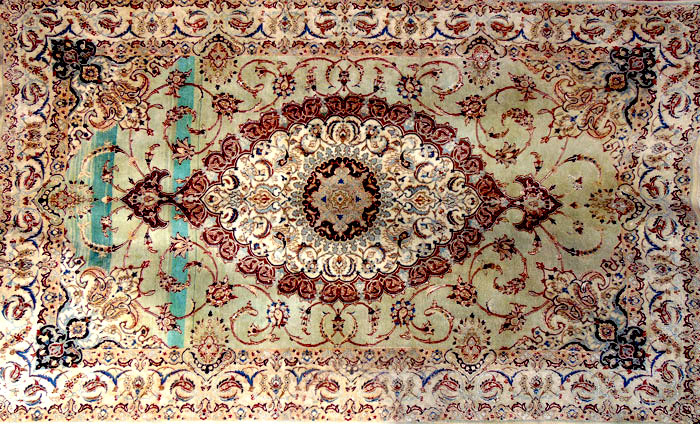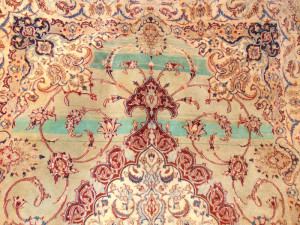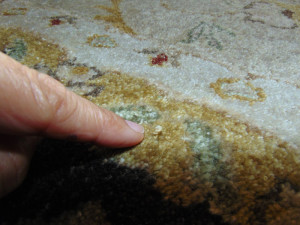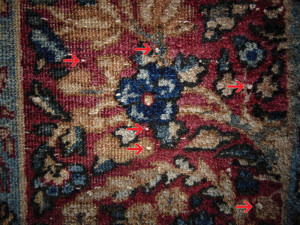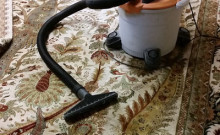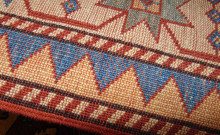So you’ve recently bought a handmade rug, and after a week or so, you notice a few things – the rug seems to shed a bit. Or maybe you notice that there seems to be some color variations in the rug. And you see some little “sprouts” of yarn above the pile. Alarmed, you’re thinking “oh no, my rug is defective!” OK… relax… take a deep breath… chances are there is nothing wrong with your rug. Handmade rugs are exactly that – works of art, made by hand, and while quality variation covers a broad spectrum, the following issues are part of the “break-in” process and quite common and usually not a cause for alarm.
Color variations (Abrash) in rugs
Abrash is the natural and variable change in color that occurs in an Oriental rug over time when different dyes are used. Many handmade rugs use natural and vegetable dyes, and the intensity of color varies between dye lots. Handmade rugs are usually woven where tools are primitive; they aren’t made in a lab! It is perfectly normal, and part of the beauty of the rug, to have color variations / abrash in a rug, especially nomadic and tribal ones.
Rug Fading
Fading in rugs is somewhat covered in the above, except that it is more related to sun exposure. If you’re rug is partially exposed to direct sun light, over time it may show some slight fading, just like anything else would. Personally, I think the natural variation gives it “character” and many times, softens the color for the better. It is recommended that you rotate your rugs every 6-12 months to ensure even wear and fading. Do not scotch guard your rug.
Rug Sprouting
Sprouting in rugs refers to when the rug appears to have undone knots, or loose threads appear to be sprouting above the pile. It’s usually not a cause for concern. You may notice this after you’ve cleaned or vacuumed your rug. The reason for sprouting is because many rugs use hand spun or hard twisted yarns of wool, and the process isn’t “perfect” like a machine. The twisting of the yarn by hand can result in inconsistent number of twists, which results in longer strands. The knot is still intact and fine, but the strand is a bit longer than the rest. No reason for alarm – your rug is not damaged or defective. The easiest way to fix it is to use some sharp scissors and trim the long strand to be even with the rest of the pile. Do not pull or tug on the strand, as you may pull out or undo the knot. I’ve noticed that the rug that my dog seems to favor has more sprouts – probably from his nails. Once a year, I’ll trim them up and all is good!
Now, if you have a hand-tufted rug and there is excessive sprouting, it could be a sign of poor construction. After all, you get what you pay for.
Rug Shedding
All handmade rugs will shed, some more than others. Hand knotted rugs shed much less than tufted rugs. Higher quality rugs will shed less as well. When rugs are made, the pile is sheared down to a certain thickness and the excess pile is combed out or shaken out once finished. It is normal for many of these loose fibers to still be embedded in the pile of the rug. Shedding will reduce and eventually stop after some vacuuming and normal use.
White spots in rug
You may notice some white dots or white knots appearing on your rug surface, especially the older ones that you’ve had for a while and have exposed to a lot of traffic. These spots are actually knots in the rug’s cotton foundation yarns that have worked their way up to the surface of the pile after wear. The strands of usually white cotton used to make the loom are joined together by knots as they run out in length. They are usually hidden in the pile fibers until the pile wears down. This is neither a defect in the rug nor an issue with the cleaning, but rather the result of normal wear and tear from the use of the rug. NOTE: Do not attempt to cut the white knots as you will create a hole in the foundation. We can fix this for you by creating dyes that best match your rug, and then spot dying all the exposed white knots.
Crookedness in rugs
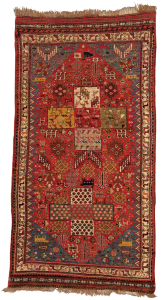 Crookedness in rugs is very common and expected. The degree of crookedness is where some may draw the line. But the reality is that these are HANDMADE works and it is very hard to make a rug perfectly straight without the use of a machine. Crookedness is part of the rugs “character”. I own several tribal and nomadic rugs and I love the crookedness in them, personally.
Crookedness in rugs is very common and expected. The degree of crookedness is where some may draw the line. But the reality is that these are HANDMADE works and it is very hard to make a rug perfectly straight without the use of a machine. Crookedness is part of the rugs “character”. I own several tribal and nomadic rugs and I love the crookedness in them, personally.
Clearwater FL Oriental Rug Specialists
In conclusion, know that your hand made rug is tougher than you think and is a work of art revered for its practicality. Use it and enjoy it! Rug imperfections are part of its unique character. If you have any questions or concerns about your rug, please drop us a line!

